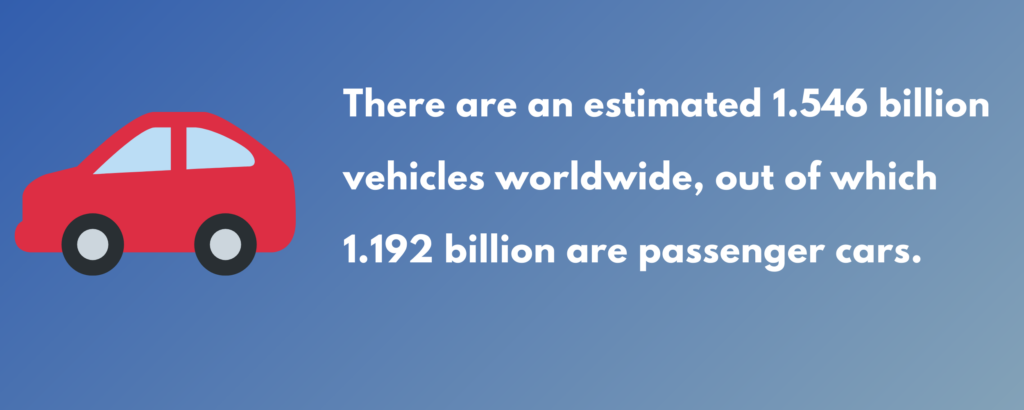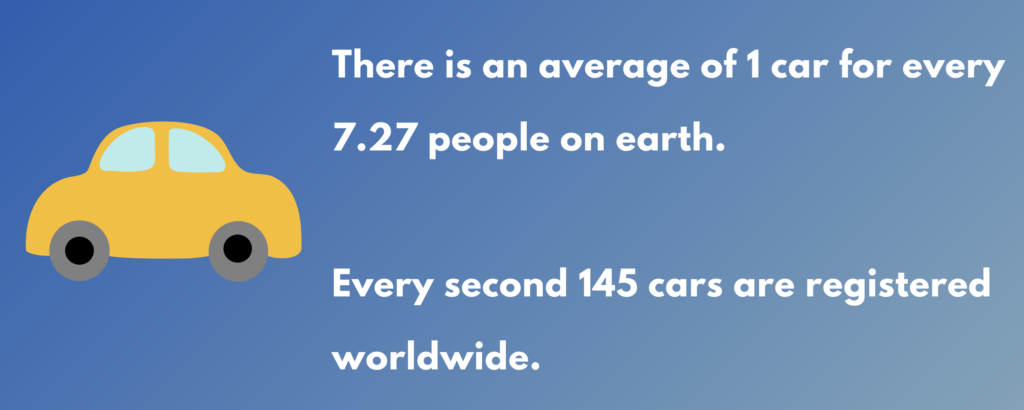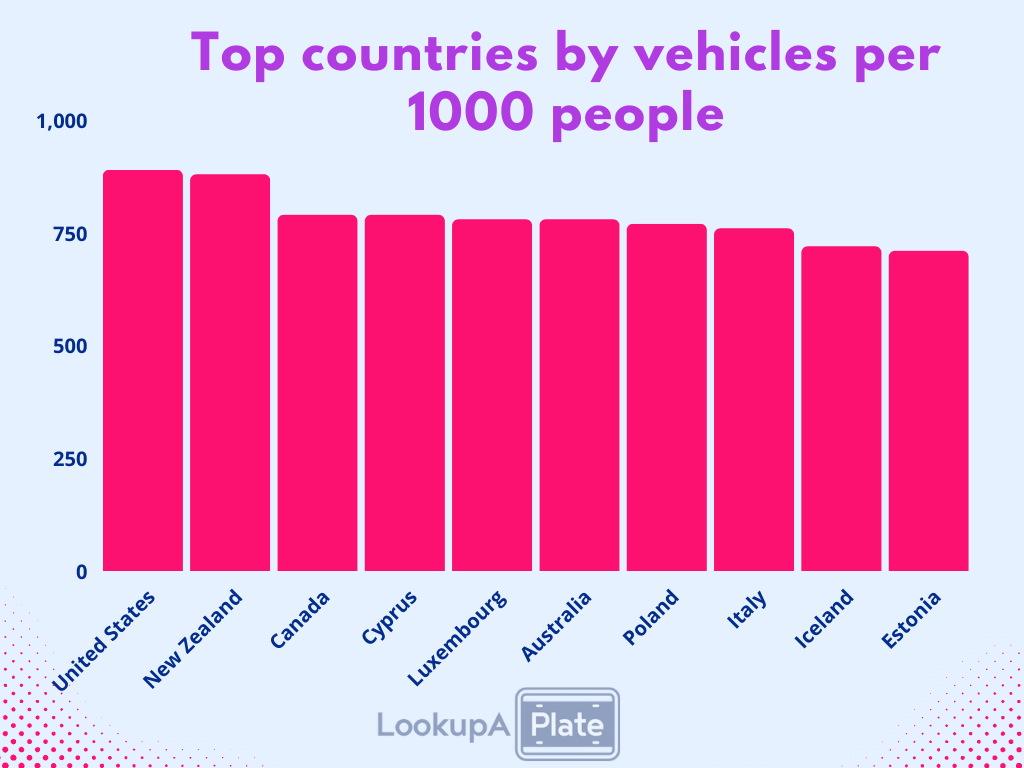There are about 8 billion people in the world, and as different as we all are, we all have the same basic needs, from food and clean water to shelter and many things in between. But is a car really one of those basic needs? In the U.S. especially, we might say so. We don’t all have access to public transportation, so cars feel essential in getting us from point A to point B.
In reality, many of us have been fortunate enough to take car ownership for granted. Indeed, 67% of Americans own at least one car. However, in lesser developed countries, car ownership simply isn’t within the realm of possibility. For a large part of the world, car ownership is seen as a luxury—a true status of wealth. In support of this, global car statistics reveal that just 18% of the world’s population own a car.
Of course, the world is always changing, and as it continues to industrialize, we will undoubtedly continue to see new cars hit the market in droves. We’ve done some digging into the current number of cars around the world and the impact it has on our environment and more. Read on to learn more.
Key Stats (Editor's Pick)
- There are an estimated 1.546 billion vehicles (passenger cars, motorcycles, buses, commercial vehicles) worldwide, out of which 1.19 billion are passenger cars
- Every second 145 cars are registered worldwide.
- China has the most cars with nearly 300 million or about 21.42% of cars in the world
- There are 294 million registered vehicles in America, or about 21% of cars in the world
- The United States has the most vehicles per capita at 0.89, when compared to other nations with a population greater than 50k
- An estimated 76 million new cars are sold worldwide every year
- In 2022, however, 80.6 million new cars were sold worldwide
- 10% of new cars sold in 2022 were fully electric (7.8 million total)
- China sells the most new cars annually, selling about 20.2 million new cars per year (about 38.33% of the world’s car sales)
- China produces the most new cars annually (25.72 million), followed by the U.S. (10.88 million) and Japan (9.68 million) (IOCA)
- Toyota was 2022’s best-selling car brand in the world
- Tesla was the top seller of electric vehicles worldwide
How many cars are there in the world?

With over a billion passenger cars on the road worldwide, there is an average of 1 car for every 7.27 people on earth. However, when looking at these statistics, there are a number of factors we must keep in mind. First, many of these numbers are taken from recent sales figures, which is difficult to come by because not every country makes this information available to the public. Second, these figures focus on cars, vans, and trucks and don’t account for other types of vehicles, such as motorcycles, which are the preferred method of transportation in many countries, particularly in Asia. What’s more, many households own more than one car, while many own none at all.
And, speaking of houses, there are an estimated 2.3 billion houses around the world (Architecture & Design), so if you, like us, were curious to know which there were more of in the world between cars and houses, you’ll be interested to know there are fewer cars than there are houses. If you weren’t curious about that fact, we’d venture to guess you are curious to know where on earth all these cars are.

Countries with the most cars per capita

When we look at which countries have the highest number of cars, the most popular number to look for is cars per capita. To understand why, we can look toward the world’s most populous country, China, as an example. There, there are nearly 300 million registered vehicles, which is more than any other country in the world. However, with a population of over 1.4 billion, China’s per capita vehicle ownership is about 0.21, which is much lower than some of the countries you’ll see on the below list. In fact, China isn’t even on the below list.
Top countries by vehicles per capita*:
- United States: 0.89 vehicles per capita
- New Zealand: 0.88 vehicles per capita
- Canada: 0.79 vehicles per capita
- Cyprus: 0.79 vehicles per capita
- Luxembourg: 0.78 vehicles per capita
- Australia: 0.78 vehicles per capita
- Poland: 0.77 vehicles per capita
- Italy: 0.76 vehicles per capita
- Iceland: 0.72 vehicles per capita
- Estonia: 0.71 vehicles per capita
To find out how many vehicles there are per thousand people, simply multiply the number of vehicles per capita by 1,000. Therefore, the United States has 890 vehicles per thousand people, New Zealand has 880 vehicles per thousand people, and so on.
*This list compares those nations with a population greater than 50k.
Countries that produce the most cars

In addition to holding the title of most registered vehicles, China also produces the highest number of cars by volume.
Below, see the top 10 car manufacturing countries of 2021, according to the International Organisation Internationale des Constructeurs d’Automobiles (IOCA):
- China: 25.72 million
- United States: 10.88 million
- Japan: 9.68 million
- Germany: 4.66 million
- India: 4.51 million
- Mexico: 3.99 million
- South Korea: 3.95 million
- Brazil: 2.94 million
- Spain: 2.82 million
- France: 2.20 million
While not the largest car producer, the United States isn’t too far behind China, earning its spot as the second-largest car manufacturer in the world. Even so, the U.S. produced fewer passenger cars than Japan and Germany. Conversely, it produced nearly double the amount of commercial vehicles as any other country and more than five times the amount of commercial vehicles than Japan.
Which manufacturer sold the most cars by units?
As previously mentioned, not every country publicly releases its recent sales figures. However, see what could be sourced insofar as top manufacturers around the world by estimated units sold in 2021 below.
- Toyota: 10.5 million
- Volkswagen Group: 8.8 million
- Renault, Nissan, Mitsubishi: 7.8 million (combined)
- Hyundai Group: 6.6 million
- General Motors: 6.3 million
- Stellantis: 6.1 million
- Honda: 4.1 million
- Ford: 3.9 million
- BMW: 2.5 million
- Mercedes-Benz: 2 million
It is important to note that technically, Renault, Nissan, and Mitsubishi are not a company; rather, they are an alliance. Also, keep in mind that some of these manufacturers include myriad brands underneath their parent companies. For example, the Volkswagen Group, ranked number two on the above list, includes Audi, Bentley, Bugatti, Ducati, Lamborghini, Porsche, SEAT, Škoda, and, of course, Volkswagen. Hyundai, on the other hand, includes Kia and Genesis.
Which manufacturer sold the most cars by revenue?
While Toyota may have sold the most vehicles, many of their top-selling models (more on that below) aren’t as expensive as their more luxury counterparts, such as Audi. Therefore, it makes sense that Volkswagen bumped Toyota out of the top spot when examining annual revenue.
Below are the top manufacturers by annual revenue generated:
- Volkswagen Group: $276 billion
- Toyota: $253 billion
- Stellantis: $167 billion
- Mercedes-Benz: $147 billion
- Ford: $136 billion
- General Motors: $127 billion
- BMW: $122 billion
- Hyundai: $96 billion
- Nissan: $66 billion
- Tesla: $54 billion
It’s certainly interesting to see brands such as Tesla make it to this list, while they weren’t featured in the top ten list of most cars sold by units.
Which model sells the most cars worldwide?
Now, which specific models are the most popular worldwide (by units sold) according to recent stats from Car Industry Analysis?
- Toyota Corolla: 1,150,000
- Toyota RAV4: 1,070,000
- Honda CR-V: 885,000
- Nissan Sentra: 705,000
- Toyota Camry: 635,000
- Ford F-150: 620,000
- Honda Civic: 560,000
- Honda HR-V: 560,000
- Chevrolet Silverado: 500,000
- Honda Accord: 500,000
Electric vehicles per capita:
We previously saw Tesla on the above top 10 list of car manufacturers by revenue; Elon Musk’s brand was also a top seller of electric vehicles (EVs) worldwide. Next in line was China’s BYD Co., followed by Chinese company SAIC Motor Corp., and Germany’s VW Group brands (Center of Automotive Management). Below, see the distribution of EVs worldwide.
Top 10 countries with the most EVs per 1,000 residents:
- Norway: 81.0
- Iceland: 36.8
- Sweden: 20.6
- Netherlands: 10.7
- Germany: 8.5
- United Kingdom: 6.7
- France: 6.5
- United States: 5.2
- China: 3.0
- South Korea: 2.9
It makes sense that the most EVs per 1,000 residents are in progressive regions such as Scandinavia and other European countries. Norway has a goal of phasing out internal combustion engine cars by 2025 as well as discussions around banning diesel-fueled cars in Oslo city center. Similarly, the European Union’s zero-emission mandate seeks to ban all new non-electric cars by 2035. Interestingly, while the U.S. and China made the cut, they’re both toward the bottom of the list. However, President Biden set an aggressive target to ensure 50% of new car sales are either electric, hybrid, or fuel-cell (hydrogen-powered) by 2030.
EVs, hybrid, and fuel-cell cars
And just how do EVs, hybrid, and fuel-cell cars stack up against each other? According to recent data from Japanese research firm MarkLines, 2021 was the year EVs out-sold hybrid cars for the first time. Global EV sales totaled 4.6m units in 2021, which the firm is crediting to high Chinese and European demand. On the other hand, about 3.1 million new hybrid vehicles were sold that same year, with about 15,000 hydrogen fuel-cell cars sold in 2021 (JATO Dynamics). While the lesser number of the three does look quite low in comparison, demand for fuel-cell cars increased by 84% from 2020 (JATO Dynamics).
How much pollution do cars produce?
We still have a ways to go regarding greener vehicle ownership, but the increase in sales over the years is promising, especially considering the environmental impact of driving. Below are some startling facts, according to the Environmental Protection Agency (EPA):
- The average passenger vehicle emits 4.6 metric tons of carbon dioxide (CO2) per year
- The average passenger vehicle emits around 404 grams of CO2 per mile
This, of course, depends on factors such as the vehicle’s fuel economy, miles driven, and more, so it’s helpful to compare the amount of tailpipe CO2 created from burning gasoline compared to diesel:
- CO2 emissions from a gallon of gasoline: 8,887 grams of CO2 per gallon
- CO2 emissions from a gallon of diesel: 10,180 grams of CO2 per gallon
On average, EVs produce less than half the amount of emissions as their traditional, fuel-powered counterparts. According to the U.S. Department of Energy, gas-powered cars emit
11.4k pounds of emissions each year, followed by hybrids (6.3k), plug-in hybrids (5.8k), and fully EV (3.9k). Of course, the electricity that both produces and charges fully EV cars is often powered by fossil fuels such as gas and coal, which is the main reason for their emissions figures.
How many cars are scrapped every year?
Another factor to consider in terms of your vehicle’s environmental impact is its recyclability, a topic with a more positive outlook. Each year, an estimated 27 million cars are recycled worldwide. From these cars, millions of tons of materials like steel and zinc are salvaged.
A look ahead
So, where does all of this leave us? Overall, it’s estimated that nearly 2 billion cars will be on the road by 2035, just about doubling our current numbers. Thankfully, more and more manufacturers have committed to ending the production of fuel-powered cars within the coming years, and the market for EVs is only expected to grow. According to the International Energy Agency, the percentage of new EV sales will need to increase by not only 20% by 2030 but also 86% by 2050 in order to reach its “Net-Zero by 2050” global emissions goal.
EV sales will, no doubt, continue to rise as more options hit the market. With millions already on the road and 1.4 billion cars worldwide, it’s clear that no matter what cars of the future look like, our reliance on them isn’t waning any time soon.
